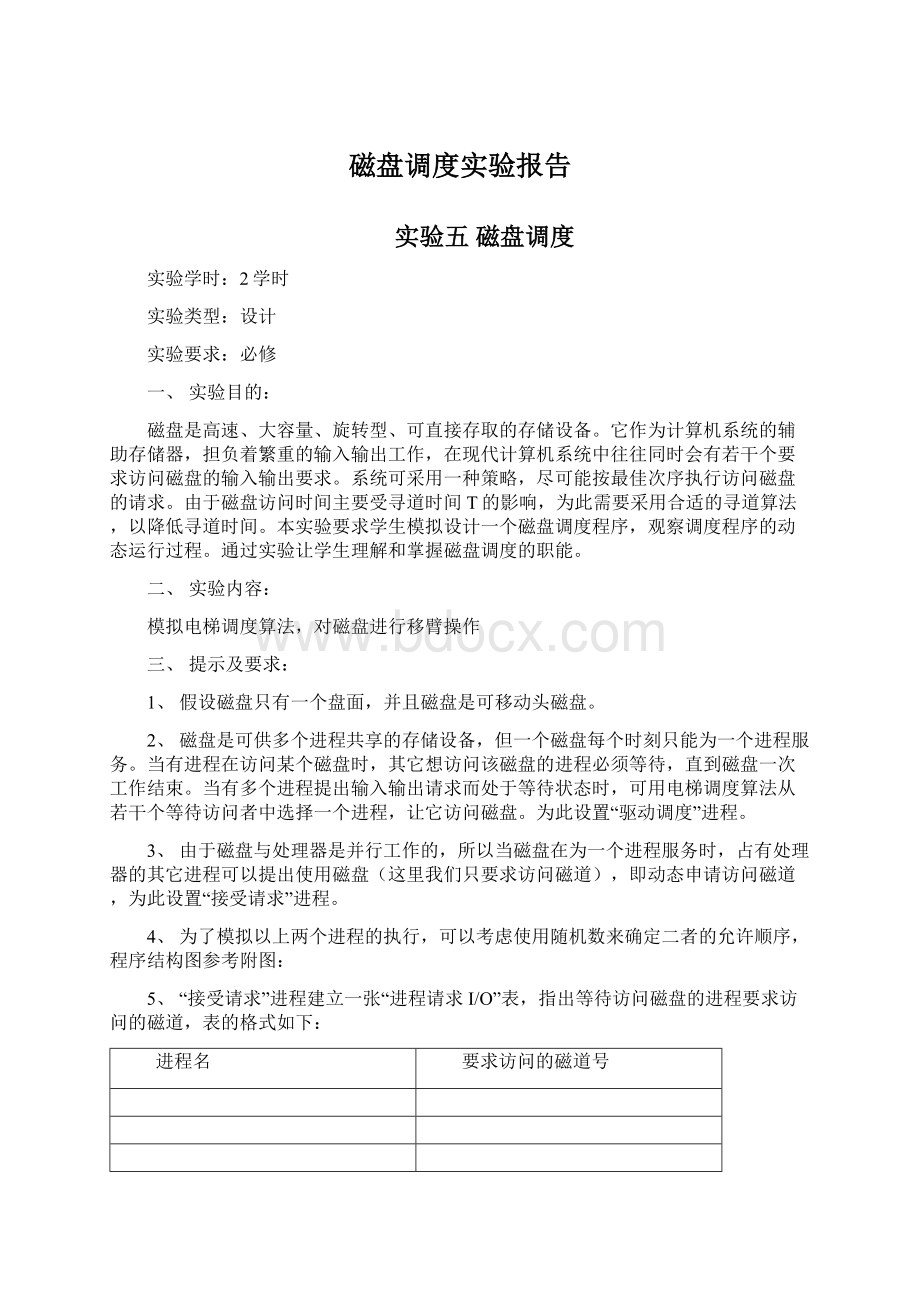磁盘调度实验报告Word文档格式.docx
《磁盘调度实验报告Word文档格式.docx》由会员分享,可在线阅读,更多相关《磁盘调度实验报告Word文档格式.docx(11页珍藏版)》请在冰豆网上搜索。

5、“接受请求”进程建立一张“进程请求I/O”表,指出等待访问磁盘的进程要求访问的磁道,表的格式如下:
进程名
要求访问的磁道号
6、“磁盘调度”的功能是查“请求I/O”表,当有等待访问的进程时,按电梯调度算法(SCAN算法)从中选择一个等待访问的进程,按其指定的要求访问磁道。
SCAN算法参考课本第九章。
算法模拟框图略。
7、附图中的“初始化”工作包括:
初始化“请求I/O”表,设置置当前移臂方向;
当前磁道号。
并且假设程序运行前“请求I/O”表中已有若干进程(4~8个)申请访问相应磁道。
四、实验报告:
1、实验题目。
2、程序中用到的数据结构及其说明。
3、打印源程序并附注释。
4、实验结果内容如下:
打印“请求I/O”表,当前磁道号,移臂方向,被选中的进程名和其要求访问的磁道,看是否体现了电梯调度(SCAN)算法。
5、体会与问题。
五、附图:
开始
初始化
磁盘调度
随机数>1/2
继续?
接受请求
输入在[0,1]区间内的随机数
结束
六实验源程序
主函数控制台main.cpp
#include<
iostream.h>
#include"
node.h"
fcfs.h"
#include"
sstf.h"
scan.h"
voidmain()
{
structnode*first=creatlist();
intn=0;
while(n!
=4)
{
cout<
<
"
请输入你的选择:
\n1:
先来先服务(FCFS)\n"
;
2:
最短寻道时间优先(SSTF)\n3:
扫描(SCAN)\n4:
退出\n"
cin>
>
n;
switch(n)
{
case1:
fcfs(first);
break;
case2:
sstf(first);
case3:
scan(first);
case4:
default:
}
}
}
先来先服务FCFS.h
#ifndefFCFS_H
#defineFCFS_H
#include<
math.h>
voidfcfs(structnode*first)
inttotal=0;
structnode*p=first->
next;
intstart=p->
track;
intlast=p->
cout<
该算法扫描磁道的顺序为\n"
while(p)
total+=abs(start-last);
//cout<
abs(start-last)<
endl;
p->
track<
->
p=p->
if(p)
last=start;
start=p->
\n先来先服务总共寻道长度:
total<
先来先服务平均寻道长度:
float(total)/9<
#endif
电梯调度算法scan.h
#ifndefSCAN_H
#defineSCAN_H
structnode*search1(structnode*,structnode*,int);
voiddel1(structnode*,structnode*);
voidscan(structnode*first)
structnode*head=newnode;
head->
next=NULL;
while(p)
structnode*s=newnode;
s->
num=p->
num;
track=p->
insert(head,s);
structnode*p2=head->
structnode*p1=head;
while(head->
next)
while
(1)
cout<
p2->
del1(p1,p2);
p1=search1(head,p2,1);
if(p1==NULL)
{
break;
}
if(p1->
total+=abs(p2->
track-p1->
next->
track);
p2=p1->
p1=search1(head,p2,-1);
if(p1==NULL)
\n扫描(SCAN)一共寻道长度:
扫描(SCAN)平均寻道长度:
double(total)/9<
structnode*search1(structnode*head,structnode*p2,inta)
structnode*q=head->
next,*re=NULL,*q1=head;
inta1=0,a2=0;
if(q)
a1=a*(q->
track-p2->
while(q)
a2=a*(q->
if((a1<
0&
&
a2>
=0)||(0<
=a2&
a2<
=a1))
re=q1;
a1=a2;
q1=q;
q=q->
returnre;
//返回相对当前磁道距离最短的磁道的前一进程要求访问的磁道位置
voiddel1(structnode*p1,structnode*p2)
p1->
next=p2->
最短距离优先调度算法sstf..h
#ifndefSSTF_H
#defineSSTF_H
structnode*search(structnode*,structnode*);
voiddel(structnode*,structnode*);
voidsstf(structnode*first)
while(p2)
del(p1,p2);
p1=search(head,p2);
if(p1->
total+=abs(p2->
p2=p1->
\n最短寻道时间优先一共寻道长度:
最短寻道时间优先平均寻道长度:
structnode*search(structnode*head,structnode*p2)
next,*re=head,*q1=head;
a1=abs(q->
a2=abs(q->
if(a2<
a1)
voiddel(structnode*p1,structnode*p2)
公共节点头信息node.h
#ifndefNODE_H
#defineNODE_H
structnode
intnum;
//进程号
inttrack;
//进程要求访问的磁道号
node*next;
};
structnode*creatlist();
voidinsert(structnode*first,structnode*s);
//插入一个节点(尾插法)
structnode*creatlist()
structnode*first=newnode;
first->
inttrackk[10]={100,55,58,39,18,90,160,150,38,184};
for(inti=0;
i<
10;
i++)
structnode*s;
s=newnode;
num=i;
track=trackk[i];
insert(first,s);
returnfirst;
voidinsert(structnode*first,structnode*s)
structnode*r=first;
structnode*p;
while(r){p=r;
r=r->
p->
next=s;
p=s;
七实验结果